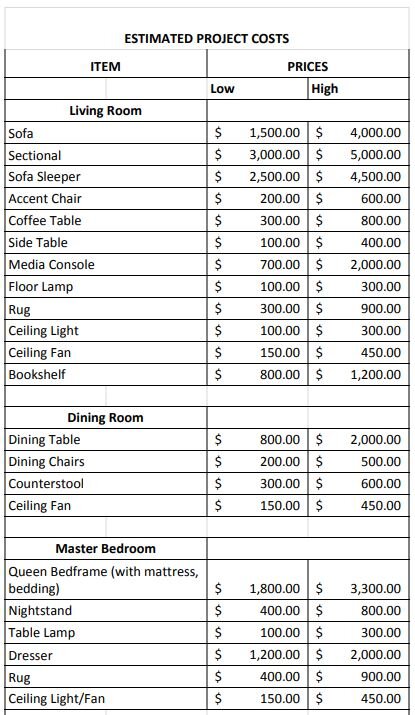This is one of my most frequently asked questions….
Let’s not focus on what you “should” spend, but instead what you are comfortable with. I like to call it value engineering- we can mix higher end items with lower end items- it all depends on where you want to invest your money. For instance if you like to entertain people and often have movie nights, I would suggest putting more a focus on a comfortable sofa and seating arrangement and less on accessories or art- we can find some great options at a fraction of the cost. Or if you like to surround yourself with well curated accessories, we can put more focus on these items, and less on the furniture in the room.
Now what would you feel comfortable investing into the purchase of your sofa? $10,000? $6,500? $3,000?
*** go through each item in the room- keep a running budget list going. Once you have gone through all large items in a room, add up all items- this is now your rough budget.***
Furniture can range a lot depending on where it was made, what materials were used, how to was constructed, among many other factors. I am often asked by potential clients what kind of price range they should expect to spend on their furniture, so I put together this little list. While these selections are very much mid to even low price points, they are a great starting point when trying to determine your budget.
These numbers were put together using average costs per each item. They are not commercial grade furniture (which can cost a lot more), but they also aren’t IKEA (sorry IKEA!) quality either. They are right in the middle.
These prices will increase every year along with inflation, among other factors. And since most people will only buy furniture every 10+ years, prices can change dramatically over long periods of time. In addition, most people don’t buy all the furniture needed for their homes in 1 single purchase. Often times, most people will buy one furniture item, then another, until they have collected all the items needed for their home. This also helps spread the “shock” of furniture costs over a longer period of time.
I share this with you in case you are considering turning your property into a short term rental. You will need to allocate a large portion of your start up costs to purchasing furniture, so this is a guide to help you budget and to know what kind of overall purchase price you should be expecting to make.













